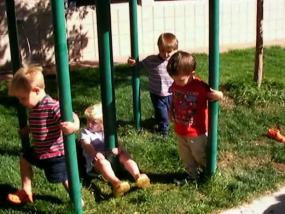Pole Play for Twos

You can study this video via several dimensions: the affordance of playground structures to support social play, the way the children adjust the rules of “Ring Around the Roses” to fit the environment, the way the children adjust their actions to avoid getting dizzy and their subsequent use dizziness as part of the “all fall down.” The fact that the poles are sufficiently separated allows children on adjacent poles to turn without colliding, yet the poles are not so far as to disallow the feeling of a group activity. Of course these children all know the “Ring Around the Roses” tune and singing that together implies they are participating in a group effort. However each child is free to turn on any unoccupied pole and turn at his/her own rate or direction. They can even leave and return since the pole marks their spot. These allowances help the game continue, given how young children need to regulate their own pace, location, and direction. The traditional method of holding hands in a large circle requires more coordination among children. The spinning on separate poles seems to be just the right level of complexity for these children playing without a teacher. Toward the end, two of the boys do “fall” down, just to mark their knowledge of the traditional game. And with continued turning one can see the boys become dizzy and begin to falter, laughing as they fall, not due to a remembered rule, but because it has become difficult to remain erect. This irony could be the reason the boys laugh. Toward the end, a third child enters and all three pivot on the poles, like teeth in a gear, tessellating but not colliding. The joy of turning (“ashes, .. ashes …. ashes”) takes dominance over the “all fall down.” How fun to come close to colliding all the while knowing the pivot keeps you separated at a fixed distance.
Length of video clip: 2 minutes 9 seconds
Keywords: Twos, Outside, Environments
